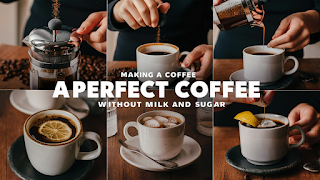How to Make Coffee without Milk and Sugar
Unlocking the Art of Brewing Coffee Without Milk and Sugar: A Comprehensive Guide
In a world where coffee culture often revolves around creamy lattes and sweetened concoctions, the allure of black coffee without milk and sugar beckons. Crafting a cup of coffee that stands on its own, devoid of additives, is an art form that requires precision, quality ingredients, and a deep appreciation for the nuances of flavor. Join us on a journey as we delve into the step-by-step process of brewing coffee without milk and sugar, exploring techniques, tips, and the essence of this pure and unadulterated beverage.
Embracing the Essence of Black Coffee:
Black coffee, devoid of milk and sugar, embodies the essence of simplicity and purity. It is a celebration of the coffee bean itself, with its inherent flavors and characteristics taking center stage. By forgoing milk and sugar, coffee enthusiasts can fully immerse themselves in the intricate flavors, aromas, and complexities that define this beloved beverage.
Step-by-Step Guide to Crafting Coffee Without Milk and Sugar:
Step 1: Selecting Premium Coffee Beans
The foundation of any exceptional cup of coffee is the quality of the beans. Opt for freshly roasted, high-quality coffee beans sourced from reputable suppliers. Look for beans that are suited to your taste preferences, whether you prefer a light, medium, or dark roast. Experiment with single-origin varieties to experience the unique terroir and flavor profiles of different coffee-growing regions.
Step 2: Grinding the Beans to Perfection
To unlock the full potential of your coffee beans, invest in a quality burr grinder. Grinding your beans just before brewing ensures maximum freshness and flavor. For black coffee without milk and sugar, a medium to coarse grind is typically recommended, as it allows for optimal flavor extraction without resulting in bitterness.
Step 3: Choosing the Right Brewing Method
There are various brewing methods available, each offering a distinct flavor profile and brewing experience. Popular options include pour-over, French press, AeroPress, and drip coffee makers. Experiment with different brewing techniques to discover which method best suits your preferences and equipment.
Step 4: Measuring the Coffee and Water Ratio
Achieving the perfect coffee-to-water ratio is essential for extracting balanced flavors and aromas. As a general guideline, use approximately one to two tablespoons of coffee grounds per six ounces of water. Adjust the ratio according to your desired strength and intensity, keeping in mind that black coffee without milk and sugar tends to be more robust in flavor.
Step 5: Mastering the Brewing Process
Follow the specific brewing instructions for your chosen method, paying careful attention to factors such as water temperature, brewing time, and agitation. Consistency and precision are key to achieving optimal results. Experiment with different variables to fine-tune your brewing technique and enhance the flavor profile of your coffee.
Step 6: Savoring the Pure Delight
Once your coffee is brewed to perfection, take a moment to savor the experience. Notice the subtle nuances of flavor, aroma, and body that characterize a well-crafted cup of black coffee without milk and sugar. Experiment with serving temperatures and presentation to elevate your coffee-drinking ritual to a sensory journey.
Q&A: Addressing Common Queries About Black Coffee:
Q: Can I enhance the flavor of black coffee without milk and sugar?
A: Absolutely! Experiment with flavor-enhancing additives such as cinnamon, nutmeg, vanilla extract, or even a splash of citrus zest. These ingredients can complement the natural flavors of the coffee beans without overpowering them.
Q: Is black coffee without milk and sugar healthier?
A: Black coffee without milk and sugar is naturally low in calories and free of added sugars, making it a healthier option for many individuals. It is also rich in antioxidants and has been associated with various health benefits, including improved cognitive function and reduced risk of certain diseases.
Q: How can I reduce the bitterness of black coffee?
A: To mitigate bitterness, consider adjusting your brewing parameters, such as grind size, water temperature, and brewing time. Opting for high-quality, freshly roasted beans with lower acidity can also result in a smoother and more balanced flavor profile.
Q: Can I use alternative milk options in black coffee?
A: While black coffee without milk and sugar is traditionally enjoyed in its purest form, some individuals may prefer the creaminess of alternative milk options such as almond, oat, or soy milk. However, keep in mind that adding these alternatives will alter the flavor profile and may not result in a traditional black coffee experience.
Exploring Related Keywords:
- Coffee brewing methods
- Specialty coffee beans
- Burr grinder vs. blade grinder
- Coffee-to-water ratio
- Brewing temperature and extraction
- Coffee flavor profiles
- Health benefits of black coffee
- Antioxidants in coffee
- Alternative milk options
- Coffee additives and flavorings
In conclusion, mastering the art of brewing coffee without milk and sugar is a journey of discovery and appreciation for the inherent qualities of the coffee bean. By selecting quality beans, mastering brewing techniques, and exploring flavor-enhancing additives, coffee enthusiasts can unlock the full potential of black coffee and elevate their coffee-drinking experience. So, embrace the simplicity and purity of black coffee, and embark on a sensory adventure unlike any other.




Comments
Post a Comment